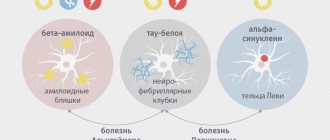Appointment with a psychiatrist at the psychiatric clinic sch.clinic +7
Dementia with Lewy bodies is characterized by chronic impairment of cognitive functions with the appearance of intracellular inclusions, called Lewy bodies, in the cytoplasm of neurons in the cerebral cortex.
Dementia in Parkinson's disease is a cognitive disorder characterized by the formation of Lewy bodies in the substantia nigra; it develops late in Parkinson's disease. Dementia is a chronic, usually irreversible, decline in cognitive function that affects all aspects of cognitive activity.
Dementia with Lewy bodies is the 3rd most common type of dementia. The onset of the disease usually occurs over 60 years of age.
Lewy bodies are spherical, eosinophilic, cytoplasmic neuronal inclusions composed of aggregates of the synaptic protein alpha-synuclein. They are found in the cerebral cortex of patients with primary dementia with Lewy bodies. With this disease, the levels of neurotransmitters change and neuronal connections between the striatum and neocortex are disrupted.
Lewy bodies are also found in the substantia nigra of patients with Parkinson's disease, and dementia (Parkinson's disease dementia) may, in some cases, develop later in the course of the disease. About 40% of patients with Parkinson's disease develop Parkinson's disease dementia; which is usually discovered at the age of 70, and 10-15 years after Parkinson's disease was diagnosed.
Because Lewy bodies are present in both dementia with Lewy bodies and dementia Parkinson's disease, some experts believe that both disorders may be part of a generalized synucleinopathy affecting both the central and peripheral nervous systems. Lewy bodies can also sometimes be detected in Alzheimer's disease, and in patients with dementia with Lewy bodies, the formation of neuritic plaques and neurofibrillary tangles is also observed in some cases. Thus, to some extent, Lewy body dementia, Parkinson's disease and Alzheimer's disease share common features. Further research is needed to clarify these relationships.
Both types of dementia - with Lewy bodies and dementia with Parkinson's disease - have a progressive course with a poor prognosis.
Dementia should not be confused with delirium, although cognitive function is impaired in both conditions. The following features usually help distinguish dementia from delirium:
- Dementia primarily affects memory, is usually caused by anatomical changes in the brain, has a slower onset and is usually irreversible.
- Delirium primarily affects attention, usually occurs during acute illness or as a result of toxic exposure (sometimes life-threatening), and is often reversible.
Other characteristic features also help differentiate dementia from delirium (see Differential Diagnosis of Delirium and Dementia*).
Clinical manifestations
Dementia with Lewy bodies
The initial decline in cognitive function in dementia with Lewy bodies resembles that in other dementias; it includes declines in memory, attention and executive function, as well as behavioral problems.
Extrapyramidal symptoms develop (usually including rigidity, bradykinesia, and gait instability) (see also Overview of Movement and Cerebellar Disorders). However, in Lewy body dementia (unlike Parkinson's disease), cognitive impairment and extrapyramidal symptoms develop in the first year of the disease. Also, extrapyramidal symptoms differ from those in Parkinson's disease; In dementia with Lewy bodies, tremor does not develop in the early stages of the disease; axial muscle rigidity and gait disturbances occur earlier, and symptoms have a symmetrical distribution. Repeated falls are common.
Fluctuation of cognitive function is a relatively specific symptom for dementia with Lewy bodies. Periods of the patient being active, with adequate behavior and orientation, may be followed by periods of confusion and lack of response to questions asked, which usually last for days or weeks, but then again give way to the ability to make contact.
Memory deteriorates, but the deterioration is manifested to a greater extent due to a lack of alertness and attention than memory itself; thus, short-term response is less affected than digit span memory (ability to repeat 7 digits forward and 5 backwards).
Patients may stare at one point for a long time. Excessive sleepiness during the day is common.
Visuospatial orientation and visuoconstructional ability (block tests, drawing a clock, or copying shapes) are more affected than other cognitive functions.
Visual hallucinations are a characteristic and often life-threatening manifestation of the disease, in contrast to benign hallucinations in Parkinson's disease. Auditory, olfactory, and tactile hallucinations are less common. In 50–65% of patients, delusions occur that are complex and bizarre in nature, which distinguishes it from simple delusions of persecution in Alzheimer's disease.
Autonomic disorders often develop with the occurrence of unexplained fainting conditions. Autonomic disturbances may occur simultaneously with the onset of cognitive deficits or shortly after their onset. Hypersensitivity to antipsychotics is typical.
Sleep disturbances are common. Many patients experience behavior disorder during rapid eye movement (REM) sleep, and parasomnia disorders are characterized by vivid dreams without the skeletal muscle relaxation typically seen in REM sleep. As a result, dreams may be accompanied by motor activity, which sometimes leads to injury to the bed partner.
We forgot the keys, we don’t remember if the iron was turned off, we can’t remember the actor’s last name? Almost everyone encounters this in everyday life. Are these signs of more serious diseases such as Parkinson's or Alzheimer's? And how to identify these diseases in the early stages in your elderly parents? Natalya Shindryaeva, neurologist, doctor of medical sciences, head physician of Moscow city clinic No. 2, tells the story.
"COUSINS"
Symptoms of Parkinson's disease are movement disturbances, slowness, and stiffness. The disease often reveals itself as tremor (shaking). Signs of Alzheimer's disease are impaired cognitive functions, difficulties with spatial orientation, remembering and reproducing information.
Any healthy person can forget something and then remember it. This is not necessarily a manifestation of serious illness. Signs of Parkinson's and Alzheimer's diseases can be identified only clinically, that is, by examination by a specialist. At the same time, MRI and CT diagnostics are used only to exclude strokes and other diseases. Suspecting Parkinson's disease, the doctor evaluates motor function using movement tests. The diagnosis of Alzheimer's disease is made on the basis of tests for all types of thinking.
Parkinson's and Alzheimer's diseases are cousins. In Parkinson's disease, biological protein accumulates in the so-called substantia nigra of the brain. Because of this, the brain is not able to produce the hormone dopamine in sufficient quantities. In Alzheimer's disease, the accumulation of the same proteins occurs in the hippocampus of the brain, and then the same negative process starts.
Often these diseases are difficult to diagnose in the initial stages. For example, Parkinson's disease manifests itself when 70% of the substantia nigra of the brain no longer functions. Until obvious symptoms appear, there are no obvious signs. This is precisely why this disease is insidious: a doctor can make a diagnosis when clinical manifestations are already evident and structural changes have occurred in the brain. Alzheimer's disease is also not always visible in time. Many of its symptoms are attributed to old age or ordinary forgetfulness.
I will talk in detail about the manifestations of these diseases. After all, the sooner a person consults a doctor, the greater the chance of maintaining vital activity longer. The situation is complicated by the fact that there is a catastrophic shortage of doctors of the relevant profile.
PARKINSON'S DISEASE
Parkinson's disease is a chronic neurodegenerative disease that, unfortunately, is steadily progressing. It is impossible to stop it, only slow it down.
The key syndrome by which we make a diagnosis is hypokenesia, that is, slowness. It is generally accepted that the main symptom of the disease is tremor, but in some people the disease proceeds without it. It’s just that when there is tremor, people go to the doctor earlier. Often, slowness and stiffness, especially in the elderly, are attributed to age, and they go to the doctor too late.
At the onset of Parkinson's disease, unilateral stiffness predominates. And then the other side of the body is involved. Parkinsonism “syndrome” also occurs in other diseases, for example, when there is chronic cerebral ischemia or cerebral circulatory failure. Sometimes similar symptoms occur due to taking antipsychotic drugs. But “syndrome” does not mean the disease itself. This means that levodopa, which is usually prescribed for Parkinson’s disease, will not be effective. It is very easy to be deceived, make an inaccurate diagnosis, and prescribe ineffective treatment.
SIGNS
A cause for concern may be a change in gait: one arm is less mobile than the other when walking. The shaking always begins initially in one arm (not the leg). Changes can be noticed in the handwriting - the patient begins to write smoothly, and towards the end of the line it slides into small letters. Trembling is observed only at rest; it is absent when moving. Anemic or mask-like face (the person seems indifferent, although in fact he is trying to smile). Stiffness appears in the body.
TREATMENT
Correctly selected therapy is important in treatment. At the first and second stages of the disease, dopamine receptor agonists (“stimulants”) are used. Above the third stage - levodopa drugs. In Parkinson's disease, there is a lack of the hormone dopamine, which provides our body with plasticity. The drugs stimulate its production. There are six groups of drugs used to treat Parkinson's disease. Therapy is always started with small doses, carefully dosed (divided into doses), and then combined with levodopa drugs. The right combination and dosage of medications helps slow the progression of the disease.
RECOMMENDATIONS
Physical activity is of great importance for patients. The disease limits movement, but the more active the patient is, the weaker the disease manifests itself. Morning exercises are very useful, which allows you to make your muscles more elastic.
ALZHEIMER'S DISEASE
Alzheimer's disease is characterized by visual-spatial impairments: for example, a person goes outside and gets lost. At the same time, he orients himself well inside a familiar room, for example, his apartment. Often the patient looks healthy from the outside, but tests reveal abnormalities. Alzheimer's disease is characterized by difficulty "receiving" information. At the same time, long-acquired professional skills are the last to be lost.
Alzheimer's disease is often confused with dementia, but they are not the same thing. Dementia can occur due to various diseases, for example, diabetes.
SIGNS
With Alzheimer's disease, the patient's relatives do not always immediately understand that something is wrong with their loved one, especially if they do not live together. A person can recite poems familiar to him from school, and his relatives will be touched by what kind of memory his grandfather has, but he will not be able to remember what he ate for breakfast. Patients are characterized by a loss of interest in life, which manifests itself in simple things. For example, a person stops watching his favorite programs. The disease can also be noticed by such manifestations as a problem with personal belongings - they are put away and cannot be found later. Or, if an elderly relative, helping a child with homework, stops coping. When he goes to the store, he doesn’t bring change. And most importantly, they begin to ask “where am I”?
TREATMENT
In Alzheimer's disease, there is a lack of acetylcholine; substances that consume it are active. The doctor must increase acetylcholine levels by suppressing substances that destroy it. Cholinesterase inhibitors and memantine group drugs are used for treatment. Always start with small doses and only one drug is prescribed. Then the dose is adjusted and the drugs are combined.
RECOMMENDATIONS
Among the recommendations not related to medications is to help the patient learn about the world around him, for example, learn poetry with him, master the computer. The most effective way to slow down the course of the disease is to learn a foreign language.
CHOOSING A TREATING DOCTOR / NEUROLOGIST
There are neurologists who know well the principle of treating such patients. I believe that in modern reality a neurologist should know this, but historically this has not been the case. And the patient can understand - they want to see a doctor who specializes in a specific disease. This is the trick of Parkinson's or Alzheimer's diseases - there are no additional methods as such, there is only the doctor's knowledge. No matter how paradoxical it may sound, and patients probably want to see special devices that detect the disease, but the main device of a doctor is his knowledge.
In our clinic we treat both Parkinson's disease and Alzheimer's disease. Help can be obtained through compulsory medical insurance (for those attached to our clinic) or on a commercial basis.
Anyone who suspects that he is ill, who understands that it is time to help relatives, needs to go to the doctor, is not afraid of the diagnosis. For example, Parkinson's disease with a predominant trembling component is a very favorable course of the disease, and with the right treatment, you can remain completely socialized without any restrictions or problems. Such patients require observation and adjustment of treatment.
HOW OFTEN DO YOU NEED TO VISIT YOUR DOCTOR?
The effect of treatment after the start of therapy, both for Alzheimer's disease and for Parkinsonism, occurs after about a month. As a rule, after your first appointment with a doctor, we recommend seeing a doctor within a month. During this period, we look at how the patient tolerates the prescribed treatment, what the clinical effect is, and whether there are any side effects. Then you can visit the doctor after six months. If something urgent happens to a patient, we call each other and take action.
When the stage of the disease is more advanced, it is advisable to conduct an examination once a quarter. If the stage is severe - once a month.
If a home visit is required, our specialist will visit your home. We have two doctors of this profile, they are the ones who treat patients.
Do I need special nutrition? Yes. The so-called Mediterranean diet should prevail. More sea fish and fresh vegetables and herbs. It is advisable to consume 200-300 grams of unsalted fish per week. It is better to bake or grill it.
ADVERTISING MATERIAL
Text / Elena Rakitkina
Photo preview / shutterstocks.com
22 328
Dementia in Parkinson's disease
In Parkinson's disease dementia (as opposed to Lewy body dementia), the cognitive impairment leading to dementia typically begins 10 to 15 years after the onset of uncontrolled motor symptoms.
Parkinson's disease dementia can affect several cognitive domains, including attention, memory, visuospatial orientation, and constructive and executive functions. Executive dysfunction tends to occur earlier and more frequently in Parkinson's disease dementia than in Alzheimer's disease.
Psychiatric symptoms (eg, hallucinations, delusions) are less frequent and/or less severe than in dementia with Lewy bodies.
In Parkinson's disease dementia, postural instability and gait abnormalities are more common, motor function declines more quickly, and falls are more common than in Parkinson's disease without dementia.
Genetic predisposition
The exact cause of these diseases has not yet been established. Research by geneticists suggests a genetic predisposition.
In Parkinson's disease, there is a failure in the production of a hormone such as dopamine. Its main function is to control the connections of different parts of the brain, which are responsible for proper motor activity.
Why can our articles be trusted?
We make health information clear, accessible and relevant.
- All articles are checked by practicing doctors.
- We take scientific literature and the latest research as a basis.
- We publish detailed articles that answer all questions.
In addition to dopamine deficiency, the following factors will help aggravate the situation:
- any head injury
- constant migraines;
- bad ecology;
- constant contact with pesticides;
- frequent consumption of large amounts of milk;
- presence of excess weight .
The occurrence of Alzheimer's disease is also attributed to a genetic failure. Factors that may aggravate the situation include the following:
- disruption of the transmission of nerve impulses;
- contact and, as a result, poisoning by toxic metals;
- injuries ;
- tumors ;
- disorders and malfunctions of the thyroid gland.
Diagnostics
- Clinical criteria
- Neuroimaging to exclude other diseases
The diagnosis is made clinically, but the sensitivity and specificity of this approach are low.
- To make a general diagnosis of dementia, all of the following criteria must be present:
- Cognitive or behavioral (neuropsychiatric) symptoms affect the ability to function at work or perform normal daily activities.
- These symptoms represent a clear decline from previous levels of functioning.
- These symptoms are not explained by the presence of delirium or a major mental disorder.
The assessment of cognitive impairment includes a history from both the patient and his acquaintances, plus a so-called bedside mental status examination or, if the results are equivocal, formal neuropsychological tests.
A diagnosis of dementia with Lewy bodies is considered probable if 2 of the following 3 features are present, and considered probable if 1 feature is present:
- Cognitive instability
- Visual hallucinations
- Parkinsonism
Criteria confirming the diagnosis include recurrent falls, syncope, disturbances in the paradoxical stage of sleep, and increased sensitivity to antipsychotics.
The overlap between symptoms of Lewy body dementia and Parkinson's disease dementia can make diagnosis difficult:
- When motor impairment (eg, tremor, bradykinesia, and muscle rigidity) precedes and is more severe than cognitive impairment, a diagnosis of Parkinson's disease dementia is usually made.
- If early cognitive impairment (in particular, executive dysfunction) and behavioral changes predominate, a diagnosis of dementia with Lewy bodies is made.
Because patients with Lewy body dementia often have attention deficits that are more common in delirium than in dementia, delirium should be assessed for delirium, particularly for common causes such as
- Taking medications (especially anticholinergic drugs, psychotropic and opioid drugs)
- Dehydration
- Infection
CT and MRI do not reveal any specific changes, but these studies are necessary to exclude other causes of dementia. Fluorine-18 (18F)-labeled deoxyglucose (fluorodeoxyglucose, or FDG) PET and 123I-FP-CIT (N-3-fluoropropyl-2β-carbomethoxy-3β-[4-iodophenyl]-tropane) single photon emission CT (SPECT) ), a fluoroalkyl analogue of cocaine, can help diagnose dementia with Lewy bodies, but are not common testing methods.
The final diagnosis requires examination of the brain substance at autopsy.
Clinical picture of Alzheimer's disease
The most typical onset is between 45 and 65 years of age, although earlier or later onset is also possible. There are three main stages of development of the disease: initial, moderate, severe dementia (dementia).
Each of them has its own characteristics. The initial stage is characterized by the appearance of the first signs of impaired memory and thinking abilities: forgetfulness, slight changes in social activity and mental activity. During this period, patients can independently compensate for the defects that appear.
In addition to the listed complaints, the appearance of anxiety, hypochondriacal and depressive states in combination with delusional disorders is possible. The duration of the initial stage varies from 15 to 20 years.
In the stage of moderate changes, a person finds it difficult to navigate in time and place, and a more obvious deterioration in memory appears, especially for events of the present time. Memory loss is characterized by a pathological shift in the focus of attention to the past, its revival. Among the mental defects, difficulties predominate: generalizations, judgments, comparisons.
In almost 2/3 of the patients, personality changes are detected: increased sensitivity, conflict, and excitability. At the same time, activity and the need for activity decrease. The ability to care for oneself is preserved (however, outside help is often required), but professional and social skills are lost.
Patients experience speech, writing, reading, and counting disorders . An objective examination of patients reveals the presence of neurological symptoms in the form of increased muscle tone, epileptic seizures, and disorders resembling Parkinson’s disease.
In the stage of severe dementia, memory decay reaches its maximum. Patients have only meager abilities with fragmentary ideas about their own personality. Mental activity is not carried out. Patients lose the ability to self-care and lose control over the functioning of the pelvic organs. They require constant care and supervision.
Patients are characterized by the inability to perform basic directed movements (for example, sit on a chair), do not recognize loved ones, do not understand from which side they are being addressed, and do not recognize themselves in the reflection. Speech disorder can be of varying degrees of severity, up to the complete absence of this function.
Basic provisions
- Because Lewy bodies appear in Lewy body dementia and Parkinson's disease, some experts suggest that both disorders are part of the same synucleinopathy that affects the central and peripheral nervous systems.
- Dementia with Lewy bodies should be suspected if dementia develops almost simultaneously with parkinsonism, and in cases where dementia is accompanied by fluctuations in cognitive function, loss of attention, the presence of psychiatric symptoms (eg, visual hallucinations; complex, bizarre delusions), and autonomic dysfunction .
- Dementia in Parkinson's disease should be suspected if dementia begins several years after the onset of parkinsonism, particularly if there is an earlier onset of executive dysfunction.
Authors: Juebin Huang, MD, PhD, Memory Impairment and Neurodegenerative Dementia (MIND) Center, University of Mississippi Medical Center Last full review/revision March 2021 by Juebin Huang, MD, PhD
Causes
The mechanisms of disease development are different, but the factors that aggravate degenerative processes in the brain are similar. It turns out that eliminating the influence of a number of irritants on the body simultaneously acts as a preventive measure for Alzheimer’s and Parkinson’s.
The following are the provocateurs of degenerative processes in the brain:
- traumatic brain injuries;
- harmful living and working conditions, poor ecology;
- severe migraines, chronic headaches;
- obesity;
- brain tumors;
- constant stress, experienced shock;
- bad habits;
- Irregular use of medications and inconsistent with the doctor.
In the case of Alzheimer's, several additional points apply. In particular, a low level of mental activity poses a danger to every person. Refusal to read, study foreign languages, or obtain higher education reduces the number of neural connections in the brain. Also
Read also: Methods and rules for diagnosing Alzheimer's disease
Brain tumors act as provocateurs of degenerative processes in the brain.










